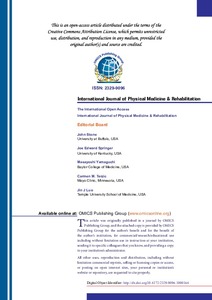| dc.contributor.author | Jaro Karppinen | |
| dc.contributor.author | Mikhail Saltychev | |
| dc.contributor.author | Katri Laimi | |
| dc.date.accessioned | 2022-10-28T14:37:52Z | |
| dc.date.available | 2022-10-28T14:37:52Z | |
| dc.identifier.uri | https://www.utupub.fi/handle/10024/172461 | |
| dc.description.abstract | <strong><span style="font-family: Arial-BoldMT; font-size: xx-small;"><span style="font-family: Arial-BoldMT; font-size: xx-small;">
<p align="left">Purpose: To investigate how well Finnish specialists in physical and rehabilitation medicine (PRM) are familiar<strong><span style="font-family: Arial-BoldMT; font-size: xx-small;"><span style="font-family: Arial-BoldMT; font-size: xx-small;"> </span></span></strong>with ICF-based concepts of functioning, capacity, and performance.</p>
<span style="font-family: Arial-BoldMT; font-size: xx-small;"><span style="font-family: Arial-BoldMT; font-size: xx-small;">
<p align="left"> </p>
</span></span></span><span style="font-family: Arial-BoldMT; font-size: xx-small;">
<p align="left"> </p>
</span></span>
<p align="left"><strong><span style="font-family: Arial-BoldMT; font-size: xx-small;"><span style="font-family: Arial-BoldMT; font-size: xx-small;">Methods: </span></span><span style="font-family: ArialMT; font-size: xx-small;"><span style="font-family: ArialMT; font-size: xx-small;">In February 2013, the 5-minute survey was conducted amongst participants at the annual meeting of</span></span><span style="font-family: ArialMT; font-size: xx-small;"><span style="font-family: ArialMT; font-size: xx-small;"> the Finnish Society of PRM. The 54 participants (response rate 81%) were asked to define the difference between </span></span><span style="font-family: ArialMT; font-size: xx-small;"><span style="font-family: ArialMT; font-size: xx-small;">concepts of functioning and capacity/performance. They were also asked to give some examples of medical tests </span></span><span style="font-family: ArialMT; font-size: xx-small;"><span style="font-family: ArialMT; font-size: xx-small;">related to these concepts. Two independent researchers evaluated the responses basing on appropriate definitions </span></span><span style="font-family: ArialMT; font-size: xx-small;"><span style="font-family: ArialMT; font-size: xx-small;">presented by ICF and researchers own experience.</span></span></strong></p>
<strong><span style="font-family: Arial-BoldMT; font-size: xx-small;"><span style="font-family: Arial-BoldMT; font-size: xx-small;"><span style="font-family: Arial-BoldMT; font-size: xx-small;"><span style="font-family: Arial-BoldMT; font-size: xx-small;">
<p align="left">Results:</p>
</span></span></span><span style="font-family: Arial-BoldMT; font-size: xx-small;">
<p align="left"> </p>
</span></span>
<p align="left"><span style="font-family: ArialMT; font-size: xx-small;"><span style="font-family: ArialMT; font-size: xx-small;">Of respondents, 83% were able to define the concept of functioning accordingly to the ICF framework </span></span><span style="font-family: ArialMT; font-size: xx-small;"><span style="font-family: ArialMT; font-size: xx-small;">as a complex relationship between health condition and contextual factors. Instead, only 24% were capable to describe concept of capacity/performance as an ability to execute single tasks in a standard or current environment. Of respondents, 40% emphasized the physical dimension of performance. Over 80% of respondents suggested at least one test for assessment of the level of performance, but only 57% introduced an example of tests for measuring limitation of functioning.</span></span></p>
<strong><span style="font-family: Arial-BoldMT; font-size: xx-small;"><span style="font-family: Arial-BoldMT; font-size: xx-small;"><strong><strong><strong><strong><span style="font-family: Arial-BoldMT; font-size: xx-small;"><span style="font-family: Arial-BoldMT; font-size: xx-small;">
<p align="left">Conclusions:</p>
</span></span><span style="font-family: ArialMT; font-size: xx-small;"><span style="font-family: ArialMT; font-size: xx-small;">The ICF-based concepts of functioning and performance were not widely used amongst Finnish </span></span><span style="font-family: ArialMT; font-size: xx-small;"><span style="font-family: ArialMT; font-size: xx-small;">physicians specialized in PRM even if the responses to survey reflected the biopsychosocial way of understanding </span></span><span style="font-family: ArialMT; font-size: xx-small;"><span style="font-family: ArialMT; font-size: xx-small;">the functioning</span></span><em><span style="font-family: Arial-ItalicMT; font-size: xx-small;"><span style="font-family: Arial-ItalicMT; font-size: xx-small;">.</span></span></em></strong></strong></strong></strong></span><strong><strong><strong><strong><span style="font-family: Arial-BoldMT; font-size: xx-small;">
<p align="left"> </p>
</span><span style="font-family: ArialMT; font-size: xx-small;"><span style="font-family: ArialMT; font-size: xx-small;">The ICF-based concepts of functioning and performance were not widely used amongst Finnish </span></span><span style="font-family: ArialMT; font-size: xx-small;"><span style="font-family: ArialMT; font-size: xx-small;">physicians specialized in PRM even if the responses to survey reflected the biopsychosocial way of understanding </span></span><span style="font-family: ArialMT; font-size: xx-small;"><span style="font-family: ArialMT; font-size: xx-small;">the functioning</span></span><em><span style="font-family: Arial-ItalicMT; font-size: xx-small;"><span style="font-family: Arial-ItalicMT; font-size: xx-small;">.</span></span></em></strong></strong></strong></strong></span>
<p align="left"><span style="font-family: ArialMT; font-size: xx-small;"><span style="font-family: ArialMT; font-size: xx-small;">The ICF-based concepts of functioning and performance were not widely used amongst Finnish </span></span><span style="font-family: ArialMT; font-size: xx-small;"><span style="font-family: ArialMT; font-size: xx-small;">physicians specialized in PRM even if the responses to survey reflected the biopsychosocial way of understanding </span></span><span style="font-family: ArialMT; font-size: xx-small;"><span style="font-family: ArialMT; font-size: xx-small;">the functioning</span></span><em><span style="font-family: Arial-ItalicMT; font-size: xx-small;"><span style="font-family: Arial-ItalicMT; font-size: xx-small;">.</span></span></em></p>
</strong></strong></strong> | |
| dc.language.iso | en | |
| dc.title | How well the ICF concepts of functioning, capacity and performance are known amongst the Finnish specialists in physical and rehabilitation medicine? | |
| dc.identifier.urn | URN:NBN:fi-fe2021042714165 | |
| dc.relation.volume | 1 | |
| dc.contributor.organization | fi=kansanterveystiede|en=Public Health| | |
| dc.contributor.organization | fi=PÄÄT LLK Kliininen laitos|en=PÄÄT LLK Kliininen laitos| | |
| dc.contributor.organization-code | 2601219 | |
| dc.contributor.organization-code | 2607307 | |
| dc.converis.publication-id | 1539230 | |
| dc.converis.url | https://research.utu.fi/converis/portal/Publication/1539230 | |
| dc.format.pagerange | 164 | |
| dc.identifier.jour-issn | 2329-9096 | |
| dc.okm.affiliatedauthor | Laimi, Katri | |
| dc.okm.affiliatedauthor | Saltychev, Mikhail | |
| dc.okm.discipline | 3141 Terveystiede | fi_FI |
| dc.okm.discipline | 3111 Biolääketieteet | fi_FI |
| dc.okm.discipline | 5142 Social policy | en_GB |
| dc.okm.discipline | 3141 Health care science | en_GB |
| dc.okm.discipline | 5142 Sosiaali- ja yhteiskuntapolitiikka | fi_FI |
| dc.okm.discipline | 3111 Biomedicine | en_GB |
| dc.okm.internationalcopublication | not an international co-publication | |
| dc.okm.internationality | International publication | |
| dc.okm.type | Journal article | |
| dc.relation.articlenumber | 1000164 | |
| dc.relation.doi | 10.4172/2329-9096.1000164 | |
| dc.relation.ispartofjournal | International Journal of Physical Medicine & Rehabilitation | |
| dc.relation.issue | 8 | |
| dc.year.issued | 2013 | |
